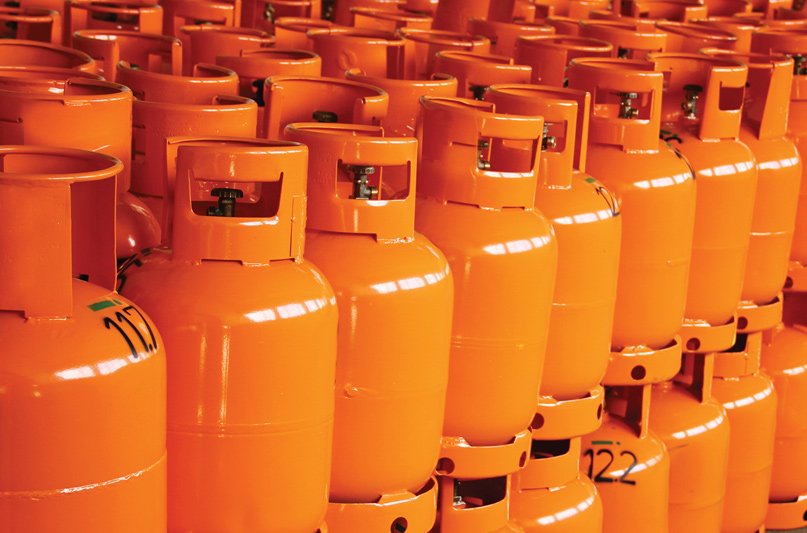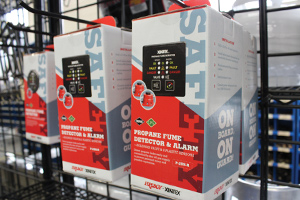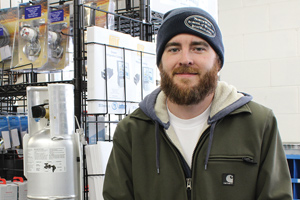“Nobody will ever totally understand Sweet Lady Propane.”
– Hank Hill, King of the Hill
 The boaters of the Pacific Northwest tend to get antsy this time of year as we round the vernal equinox and leave the darkest days behind us. Is it just me, or does it feel like the next on-water BBQ with friends after a sunny day cruising Puget Sound is just around the corner? It’s with the anticipation of the delicious meals awaiting us this cruising season that we turn our attention to our propane systems.
The boaters of the Pacific Northwest tend to get antsy this time of year as we round the vernal equinox and leave the darkest days behind us. Is it just me, or does it feel like the next on-water BBQ with friends after a sunny day cruising Puget Sound is just around the corner? It’s with the anticipation of the delicious meals awaiting us this cruising season that we turn our attention to our propane systems.
Propane has been a mainstay onboard for generations, giving boats that don’t have massive generators the freedom to cook as they please. Simple and effective, propane is also extremely explosive and can accumulate in a deadly cloud not unlike carbon monoxide. These pros and cons beg the question, what goes into a safe, dependable propane system?
To sate our curiosity, we turn to Graham Milgate, Seattle-based ace technician with Ballard, Seattle’s Sure Marine Service. We picked Milgate’s brain right after a three-day workshop about heating systems as part of the Northwest School of Wooden Boat Building’s relatively new systems curriculum where he served as a guest speaker. The big takeaways from our conversation were to stick to the American Boat and Yacht Council (ABYC) safety recommendations and be safe!
NWY: So, we’re here in Propane 101. What are the general components of a boat’s propane system?
The main thing is that there are extra safety precautions when using propane on a boat because propane is heavier than air. On a boat you are physically confined in a relatively small space. The propane can leak and accumulate inside the vessel, leading to a potentially dangerous explosion. So importantly, the ABYC creates many recommendations for safety. While these recommendations are not necessarily law, if you don’t follow their rules
and something bad became of it, they will ask why you didn’t follow those guidelines. If you didn’t have a really good reason for not following the ABYC recommendations, you can potentially be held accountable for whatever happened.
A major consideration for installation is the proper mounting of a propane system. That will be either with a locker box, which is going to be sealed and vented overboard, or physically hanging overboard with a rail-mount assembly. The ABYC recommendations state that if propane were to leak, it should always leak overboard. That’s why these two, locker and rail mounts, are your main options.
These mounting schemes will accommodate: propane tank; regulator that reduces the propane pressure to a useable amount for your appliance; solenoid, a valve that you can turn on and off with a switch to physically turn the propane on and off; your hose that runs the propane to your appliance; and your appliance.
Another component you’ll definitely need is a 0 to 300 psi gauge to be able to perform leak-down tests. Essentially you turn your propane on and pressurize the whole system, and then turn that propane back off. If the needle on your gauge moves at all in three minutes after you turn it off, you have a leak and you’ll need to go through the system to find it.
NWY: Are there other uses for propane aboard, or is it all for the galley?
You are correct that the vast majority of propane systems are used for cooking aboard. Propane from an efficiency standpoint is superior to electrical on almost all vessels for this purpose. If you have a generator you can run all the time, then electric can work just fine. But if you’re on a 30’ vessel without a large genset, then propane allows you to cook away from the dock without eating your battery charge.
We certainly sell propane heaters, but they are less popular than say diesel heaters because you need to burn a whole lot of propane to get the same results. Additionally, diesel heaters can draw from the diesel fuel that’s probably already on board, a big advantage for heaters.
We don’t work with outboards, but there are some cool new outboards that use propane as their fuel source. There’s one where a green bottle—the kind you get from the gas station—screws right into the motor and you’re set. The safety aspect with propane systems certainly limits the applications a bit.
NWY: What are some considerations or limitations that come into play when designing or installing a propane system?
When you’re talking about where to mount a locker, a locker must open directly to fresh air. Essentially, it must be mounted above deck and it can’t share any equipment with other systems. That is a big factor in most boat owners’ decision making when it comes to mounting a system.
If you have extra deck space, you can put a roto-molded or fiberglass locker box where it’s not in the way. Otherwise, we have a custom-made, rail-mounted system for people who don’t have spare space on their deck to put the propane.
NWY: Is every job essentially a custom job, where the characteristics of the boat need to be considered? Or does one size fit all?
In a way, it’s custom. The lockers we sell means that buyers who are self-installing will be drilling holes for the drain and electrical going in, the solenoid valve for the propane housing, etc. You get all the standard components you need, but the end-user or their boatyard installer will be taking custom measurements such as the amount of hose and the like. So, the installation is variable between boats but the components are usually the same.
The hoses are relatively expensive because they have to be non-permeating. You don’t want to have $50 worth of extra hose coiled up just because you didn’t measure something correctly.
NWY: Where does the DIY vs. professional boundary for propane systems lie? It sounds like you can do a lot of it yourself, but you do want to stay safe.
It’s going to come down to what you’re comfortable with. There are plenty of people who are handy, experienced, and perfectly capable of installing a propane system, but they just don’t want to mess with that and will get a professional to install it for them. As long as you’re handy and stay familiar with the ABYC rules, you should be fine.
Bottom line is that there are safety components and resources aplenty to stay safe. Of course, if you do want to go with a professional installer, there are plenty of those as well. Be diligent, remember the question “If the propane is not burning, where is it going?” to make sure it’s venting overboard.
NWY: In addition to the leak-down test, do you have any suggestions for staying safe?
It’s not a requirement per the U.S. Coast Guard or the ABYC, but it’s common to have a propane sniffing device on board. They come as both stand-alone detectors like a carbon monoxide detector and as a built-in model in your solenoid. If you have your solenoid on and there’s a leak, the built-in systems will not only sound an alarm but shut your system off to stop the propane from accumulating on your boat.
NWY: Once installed and working perfectly, is there regular maintenance you recommend?
Annual checkups aren’t necessary, but you should do a leak-down test occasionally. Replace those hoses every eight or ten years, or to whatever they’re rated for. Your solenoid is an electromagnetic coil, so it’ll eventually burn out. Besides those pointers, just be cognizant that you have propane aboard, that it’s heavier than air and very flammable.
NWY: Are there any projects recently that were particularly memorable? Why?
I wasn’t on this job, but there was a boat recently that had its propane system installed in Europe. It’s important to keep in mind that every country has its own regulations about how installations should take place. In Europe, it’s common practice to use hose clamps for propane hoses instead of farrules that are crimped, like in the U.S. That’s just not acceptable in the U.S. This particular boat that came to the U.S. from Europe had thousands of dollars of propane equipment that had to be ripped out and reinstalled.
Also in the States, you can’t have any connectors that don’t run directly to the appliance or inside the locker. This is so the leaks go directly overboard. If you want to run two separate appliances, you need to run separate hoses from your locker directly to the appliance. It’s not like that everywhere abroad.
NWY: Is there an even split between sailboats and motorboats when it comes to propane on board?
Sure, it’s less about power vs. sail and more about what you’re using your boat for. If you’re at the dock most of the time, a little electric stovetop might do you just fine. But if you want to get away from the dock for extended time, propane is usually the way to go for both power and sail without large generators. There’s 93,000 BTUs in a gallon of propane and most stoves are run at 5,000 or 7,000 BTUs, so you can get very far on a single burner with a typical five-gallon tank of propane.
Propane is readily available, but you often get butane in warmer climates. Butane is similar but performs better in warmer climates, while propane does better in cooler climates. They are very similar gases that operate at slightly different BTUs per gallon. If you hooked up a butane canister to a propane stove, it’s not 100 percent the safest thing you can do, but you may not even notice a difference. If you went natural gas in a propane system, you’d have bigger problems.
NWY: Any concluding thoughts?
Safety first!




